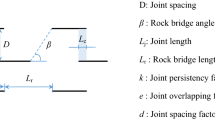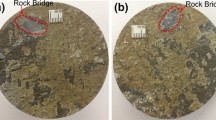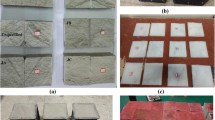Abstract
The interaction between the joints and the rock bridge beforehand is very complex, which is mainly reflected in the sequence of mobilization and stress distribution between them. To better understand the influence of the rock bridge, direct shear tests were carried out through a newly proposed method on rock specimens which contain two parallel incipient joints. As an innovative study, a method of preparing specimens using 3D printing technology is presented and the localized deformation in rock bridge and joint area is of interest. Test results showed that the failure process of nonpersistent closed rough joints can be divided into seven stages. The seven stages have been successfully verified using PFC2D (Particle Flow Code 2D). The joint surface roughness influences the mobilization pattern by altering the failure process, while rock bridges can weaken the transmission of shear stress, causing the mobilization displacements of the joints on either side of the rock bridge to be out of sync. The roughness of the joint surface after shearing increases with increasing initial JRC. The rock bridge reduces the peak displacement of the joint surface by altering the degree of wear of the joint surface; and the peak displacement of the rock bridge increases due to the unsynchronised mobilization of the joint surface on either side of the rock bridge, thus altering the failure behavior of the rock joints.
Highlights
-
By analyzing the localized deformation of a rock bridge and joint surfaces, the interaction between them and the shear failure characteristics of the whole joint plane were investigated.
-
Rock bridge in nonpersistent joints weakens the transmission of shear stress, causing the mobilization displacements of the joints on either side of the rock bridge to be out of sync.
-
The peak displacement of the rock bridge increases due to the unsynchronized mobilization of the joint surface on either side of the rock bridge, thus altering the failure behavior.


















Similar content being viewed by others
Data Availability
The data supporting the fndings of this study are available from the corresponding author upon reasonable request.
References
Asadizadeh M, Moosavi M, Hossaini MF et al (2017) Shear strength and cracking process of non-persistent jointed rocks: an extensive experimental investigation. Rock Mech Rock Eng 51:415–428
Bahaaddini M, Hagan PC, Mitra R et al (2014) Scale effect on the shear behaviour of rock joints based on a numerical study. Eng Geol 181:212–223
Bahaaddini M, Hagan PC, Mitra R, Hebblewhite BK (2015) Parametric study of smooth joint parameters on the shear behaviour of rock joints. Rock Mech Rock Eng 48:923–940
Barton N, Choubey V (1977) The shear strength of rock joints in theory and practice. Rock Mech Rock Eng 10:1–543
Einstein HH, Veneziano D, Baecher GB et al (1983) The effect of discontinuity persistence on rock slope stability. Int J Rock Mech Min Sci 20(5):227–236
Ellefmo SL, Eidsvik J (2009) Local and spatial joint frequency uncertainty and its application to rock mass characterisation. Rock Mech Rock Eng 42:667–688
Gehle C, Kutter HK (2003) Breakage and shear behavior of intermittent rock joints. Int J Rock Mech Min Sci 40:687–700
Gerolymatou E, Triantafyllidis T (2016) Shearing of materials with intermittent joints. Rock Mech Rock Eng 49:2689–2700
Giwelli A, Esteban L, Lemiale V et al (2017) Hydromechanical behavior of a synthetic homogenous carbonate rock during direct shear. ISRM European rock mechanics symposium-EUROCK. Procedia Eng. 191:811–820
ISRM (1978) Suggested methods for the quantitative description of discontinuities in rock masses. Int J Rock Mech Min Sci 15:319–368
Jennings JE (1970) A mathematical theory for the calculation of the stability of slopes in open cast mines. Plan Open Pit Mines Proc Johannesburg 21(2):87–102
Lajtai EZ, Carter BJ, Duncan EJS (1994) En echelon crack-arrays in potash salt rock. Rock Mech Rock Eng 27:89–111
Lajtai EZ (1969a) Strength of discontinuous rocks in direct shear. Geotechnique 19:218–332
Lajtai EZ (1969b) Shear strength of weakness planes in rock. Int J Rock Mech Min Sci 6(5):499–515
Liu YM, Xia CC (2006a) Study on fracture mechanism and criteria of failure strength of rock mass containing coplanar closed discontinues joints under direct shear. Chin J Rock Mech Eng 25:2086–2086
Liu YM, Xia CC (2006b) Study on models and strength behavior of rock mass containing discontinuous joints in direct shear. Chin J Geotech Eng 10:1242–1247
Martin CD, Chandler NA (1994) The progressive fracture of Lac du Bonnet granite. Int J Rock Mech Min Sci 31:643–659
Paronuzzi P, Bolla A, Rigo E (2016) 3D stress-strain analysis of a failed limestone wedge influenced by an intact rock bridge. Rock Mech Rock Eng 49:3223–3242
Patton FD (1966) Multiple modes of shear failure in rock. 1st ISRM Congress OnePetro
Pine RJ, Coggan JS, Flynn ZN, Elmo D (2006) The development of a new numerical modelling approach for naturally fractured rock masses. Rock Mech Rock Eng 39:395–419
Saadat M, Taheri A (2020) A numerical study to investigate the influence of surface roughness and boundary condition on the shear behaviour of rock joints. Bull Eng Geol Environ 79(5):2483–2498
Scavia C (1990) Fracture mechanics approach to stability analysis of rock slopes. Eng Fract Mech 35:899–910
Tang ZC, Wong NYL (2016) New criterion for evaluating the peak shear strength of rock joints under different contact states. Rock Mech Rock Eng 49(4):1191–1199
Wang G, Zhang YZ, Jiang YJ, Liu PX, Guo YS, Liu JK et al (2018) Shear behavior and acoustic emission characteristics of bolted rock joints with different roughness. Rock Mech Rock Eng 51(6):1885–1906
Wong RHC, Chau KT (1998) Crack coalescence in a rock-like material containing two cracks. Int J Rock Mech Min Sci 35:147–164
Yang XX, Kulatilake PHSW (2019) Laboratory investigation of mechanical behavior of granite samples containing discontinuous joints through direct shear tests. Arabian J Geosci 12:79
Yang XX, Qiao WG (2018) Numerical investigation of the shear behavior of granite materials containing discontinuous joints by utilizing the flat-joint model. Comput Geotech 104:69–80
Acknowledgements
The research reported in this manuscript was founded by the National Natural Science Foundation of China (Grant No. 52274088), Natural Science Foundation of Shandong province (Grant No. ZR2022ME056) and Research and Innovation Team Project of College of Civil Engineering and Architecture, SDUST (Grant No. 2019TJKYTD02). The suggestions on improving the presentation of this paper given by Prof. Yan Xing from The China University of Mining and Technology were greatly appreciated.
Author information
Authors and Affiliations
Corresponding author
Additional information
Publisher's Note
Springer Nature remains neutral with regard to jurisdictional claims in published maps and institutional affiliations.
Rights and permissions
Springer Nature or its licensor (e.g. a society or other partner) holds exclusive rights to this article under a publishing agreement with the author(s) or other rightsholder(s); author self-archiving of the accepted manuscript version of this article is solely governed by the terms of such publishing agreement and applicable law.
About this article
Cite this article
Wang, S.C., Yang, X.X., Li, W.T. et al. Influence of a Rock Bridge on the Shearing Behavior of Nonpersistent Rough Joints: An Experimental Study. Rock Mech Rock Eng 56, 2573–2588 (2023). https://doi.org/10.1007/s00603-023-03225-2
Received:
Accepted:
Published:
Issue Date:
DOI: https://doi.org/10.1007/s00603-023-03225-2




